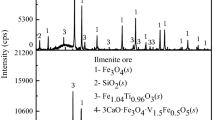Abstract
Aventurine type crystallization glazes containing hematite (α-Fe2O3) as reddish-brown crystals with golden reflexes are well known for their highly decorative effect. This effect is conditioned by the vitreous matrix composition selected to have a positive influence over the hematite crystallization process producing crystals with suitable shape and size. This paper promote the use of a glass waste—cathode ray tube (CRT) the funnel glass section (15÷60 wt%)—along with the traditional raw materials (borax, boric acid, quartz, and iron oxide) to obtain the aventurine frits. The mixture of CRT waste and raw materials containing 15÷20 % Fe2O3 was melted at a temperature of 1,250 °C with 30 min soaking time. Black granular frits were obtained after pouring the melts in cold water. The glaze slurry was prepared using the obtained frits (95 %) and kaolin (5 %) as suspension material. The crystallization kinetics of the aventurine type glaze has been investigated using the linear integral isoconversional methods described by Kissinger–Akahira–Sunose, Ozawa–Flynn–Wall, Starink and Tang, and also the non-linear integral isoconversional method described by Vyazovkin. The apparent activation energy of the hematite crystallization in the studied aventurine glazes ranges with the crystallized fraction between 190 and 262 kJ mol−1 for the frit with 3.82 % LiF and between 256 and 281 kJ mol−1 for the frit 3.82 % CaF2, respectively.









Similar content being viewed by others
References
Wanie W. Kristalline glasuren und Kristallglasuren. Glas-Email-Keramo-Techik. 1965;16(11):413–7.
Levitskii IA. Mechanism of phase formation in aventurine glaze. Glass Ceram. 2001;58(5–6):223–6.
Dakhai S, Orlova LA, Mikhailenko NYu. Types and compositions of crystalline glazes (a review). Glass Ceram. 1999;56(5–6):177–80.
Dvornichenko IN, Matsenko SV. Production of iron-containing crystalline glazes. Glass Ceram. 2000;57(1-2):67–9.
SYu Eliseev, Rodtsevich SP, Dostanko EV. Enamel with the aventurine effect. Glass Ceram. 2000;57(3–4):140–2.
Casasola R, Ma Rinco’n J, Romero M. Glass–ceramic glazes for ceramic tiles: a review. J Mater Sci. 2012;47:553–82.
Păcurariu C, Lazău RI, Lazău I. Aventurine decorative glazes—kinetic study of α-Fe2O3 crystallization. Rom J Mater. 2011;41(4):346–51.
Păcurariu C, Lazău RI, Lazău I, Tiţa D, Dumitrel A. Non-isothermal crystallization kinetics of some aventurine decorative glaze. J Therm Anal Calorim. 2011;105:435–41.
Andreola F, Barbieri L, Corradi A, Ferrari AM, Lancellotti I, Neri P. Recycling of EOL CRT glass into ceramic glaze formulations and its environmental impact by LCA approach. Int J LCA. 2007;12(6):448–54.
Dima V, Eftimie M, Volceanov A, Voicu G, Dincă R. Possibilities for recovery of some glass waste from cathode ray tubes. Rom J Mater. 2012;42:76–81.
Andreola F, Barbieri L, Corradi A, Lancellotti I. CRT glass state of the art—a case study: recycling in ceramic glazes. J Eur Ceram Soc. 2007;27:1623–9.
Vyazovkin S, Wight CA. Model-free and model-fitting approaches to kinetic analysis of isothermal and non-isothermal data. Thermochim Acta. 1999;340–341:53–68.
Starink MJ. The determination of activation energy from linear heating rate experiments: a comparison of the accuracy of isoconversion methods. Thermochim Acta. 2003;404:163–76.
Vyazovkin S, Burnham AK, Criado JM, Pérez-Maqueda LA, Popescu C, Sbirrazzuoli N. ICTAC kinetics committee recommendations for performing kinetic computations on thermal analysis data. Thermochim Acta. 2011;520:1–19.
Starink MJ. Activation energy determination for linear heating rate experiments: deviations due to neglecting the low temperature end of the temperature integral. J Mater Sci. 2007;42:483–9.
Murray P, White J. Kinetics of the thermal dehydration of clays. IV. Interpretation of the differential thermal analysis of the clay minerals. Trans Brit Ceram Soc. 1955;54:204–38.
Kissinger HE. Reaction kinetics in differential thermal analysis. Anal Chem. 1957;29:1702–6.
Akahira T, Sunose T. Trans joint convention of four electrical institutes, Research report, Chiba Institute of Technology. Sci Technol. 1971;16:22–31.
Criado JM, Sanchez-Jimenez PE, Perez-Maqueda LA. Critical study of the isoconversional methods of kinetic analysis. J Therm Anal Calorim. 2008;92:199–203.
Cai JM, Liu RH. Precision of integral methods for the determination of the kinetic parameters. Use in the kinetic analysis of solid-state reactions. J Therm Anal Calorim. 2008;91(1):275–8.
Farjas J, Roura P. Isoconversional analysis of solid state transformations. J Therm Anal Calorim. 2011;105:757–66.
Cai JM, Liu RH. Non-isothermal kinetics in solids. The precision of some integral methods for the determination of the activation energy without neglecting the temperature integral at the starting temperature. J Therm Anal Calorim. 2008;94:313–6.
Pratap A, Rao TLS, Lad KN, Dhurandhar HD. Isoconversional vs. model fitting methods. A case study of crystallization kinetics of a Fe-based metallic glass. J Therm Anal Calorim. 2007;89(2):399–405.
Chen HX, Liu NA. Approximations for the temperature integral. Their underlying relationship. J Therm Anal Calorim. 2008;92(2):573–8.
Burnham AK, Dinh LN. A comparison of isoconversional and model-fitting approaches to kinetic parameter estimation and application predictions. J Therm Anal Calorim. 2007;89(2):479–90.
Vyazovkin S, Dollimore D. Linear and nonlinear procedures in isoconversional computations of the activation-energy of non-isothermal reactions in solids. J Chem Inf Comp Sci. 1996;36:42–5.
Vyazovkin S. Advanced isoconversional method. J Therm Anal Calorim. 1997;49:1493–9.
Vyazovkin S, Dranca I. Isoconversional analysis of combined melt and glass crystallization data. Macromol Chem Phys. 2006;207:20–5.
Gorbachev VM. A solution of the exponential integral in the non-isothermal kinetics for linear heating. J Thermal Anal Calorim. 1975;8(2):349–50.
Acknowledgements
This work was partially supported by the strategic Grant POSDRU/89/1.5/S/57649, Project ID 57649 (PERFORM-ERA), co-financed by the European Social Found—Investing in People, within the Sectoral Operational Programme Human Resources Development 2007–2013.
Author information
Authors and Affiliations
Corresponding author
Rights and permissions
About this article
Cite this article
Lazău, I., Borcănescu, S., Păcurariu, C. et al. Kinetic study of the non-isothermal crystallization process of hematite in ceramic glazes obtained from CRT wastes. J Therm Anal Calorim 112, 345–351 (2013). https://doi.org/10.1007/s10973-012-2736-1
Received:
Accepted:
Published:
Issue Date:
DOI: https://doi.org/10.1007/s10973-012-2736-1




